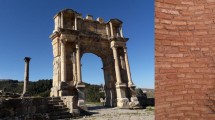Abstract
The Fine Arts Department of Thailand excavated parts of the city walls in the western part of Songkhla city, Southern Thailand. This excavation found additional brick walls covering the top and sides of a rock wall, which according to historical records was built between AD 1836 and 1842. In this paper, we use optically stimulated luminescence (OSL) to date the brick attachments in order to understand the construction history of Songkhla City Wall. In total, eight brick samples were collected from the top (five samples) and the side (three samples) of the rock wall. All but one sample have excellent OSL properties and the exception is explained by limited burning of this particular brick during the production process, as also indicated by material properties. The major challenge of this study was the correct reconstruction of the dose rate due to the complex situation onside and the limited documentation. Despite these limitations, our results imply that the rock wall and the bricks attached to its side are contemporaneous. The bricks on top of the rock wall date to AD 1853–1865, a time shortly before a royal visit (King Rama V) to Songkhla in AD 1870. Two samples dating to the latest nineteenth century may imply a later restoration phase.









Similar content being viewed by others
References
Aitken MJ (1985) Thermoluminescence dating. Academic press, London, U.K
Aitken MJ (1998) Optical dating. Oxford University Press, U.K
Bailiff IK (2007) Methodological developments in the luminescence dating of brick from English Late-Medieval and Post-Medieval buildings. Archaeometry 49:827–851
Bailiff IK, Holland N (2000) Dating bricks of the last two millennia from Newcastle upon Tyne: a preliminary study. Radiat Meas 32:615–619
Blain S, Bailiff IK, Guibert P, Bouvier A, Baylé M (2010) An intercomparison study of luminescence dating protocols and techniques applied to medieval brick samples from Normandy (France). Quat Geochronol 5:311–316
Chruścińska A, Cicha A, Kijek N, Palczewski P, Przegiętka K, Sulkowska-Tuszyńska K (2014) Luminescence dating of bricks from the gothic Saint James Church in Toruń. Geochronometria 41:352–360
Feathers JK (2003) Use of luminescence dating in archaeology. Meas Sci Technol 14:1493–1509
Galbraith R, Roberts RG, Laslett GM, Yoshida H, Olley JM (1999) Optical dating of single and multiple grains of quartz from Jinmium rock shelter, Northern Australia: part I, experimental design and statistical models. Archaeometry 41:339–364
Goedicke C, Slusallek K, Kubelik M (1981) Thermoluminescence dating in architectural history: Venetian villas. J Soc Archit Hist 40:203–217
Government Gazette (1976) Announcement of the Fine Arts Department on the registration of historical sites. Retrieved from http://www.ratchakitcha.soc.go.th
Murray AS, Wintle AG (2000) Dating quartz using an improved singlealiquot regenerative-dose (SAR) protocol. Radiat Meas 32:57–73
Lakho NA, Zardari MA (2016) Structural properties of baked clay bricks fired with alternate fuels. Engineering 8:676–683
Pailoplee S, Won-In K, Chaisuwan B, Charusiri P (2016) Thermoluminescence and optically stimulated luminescence dating of bricks from the Thung Tuk archaeological site, Southern Thailand. Songklanakarin J Sci Technol 38:699–705
Pietsch TJ, Olley JM, Nanson GC (2008) Fluvial transport as a natural luminescence sensitiser of quartz. Quat Geochronol 3:365–376
Preusser F, Ramseyer K, Schlüchter C (2006) Characterisation of low OSL intensity quartz from the New Zealand Alps. Radiat Meas 41:871–877
Preusser F, Degering D, Fuchs M, Hilgers A, Kadereit A, Klasen N, Krbetschek M, Richter D, Spencer J (2008) Luminescence dating: basics, methods and applications. E&G Quaternary Sci J 57:95–149
Preusser F, Chithambo ML, Götte T, Martini M, Ramseyer K, Sendezera EJ, Susino GJ, Wintle AG (2009) Quartz as a natural luminescence dosimeter. Earth Sci Rev 97:196–226
Richter D, Richter A, Dornich K (2015) Lexsyg Smart—a luminescence detection system for dosimetry, material research and dating application. Geochronometria 42:202–209
Royal Academy Council (1933) Historical annals section 53; Chronicles of Songkhla, Chronicles of Nakhon Si Thammarat, Chronicles of Phatthalung, cremation ceremony of Phra Phitak Sakornket (yak Leelabutra) on may 18, 1933, Sophon Phiphan Thanakorn printing factory, pp.28–40
Takashima I (1994) Thermoluminescence age determination of lava flows/domes and collapsed materials at Unzen Volcano, SW Japan. Bull Volcanol Soc Japan 39:1–12
Takashima I, Honda S (1989) Comparison between K-Ar and TL dating results of pyroclastic flow deposits in the Aizutajima area, Northeast Japan. Chishitsugaku Zasshi 95:807–816
Wintle AG, Murray AS (2006) A review of optically stimulated luminescence characteristic and their relevance in single-aliquot regeneration dating protocols. Radiat Meas 41:369–391
Won-in K, Wattanadul P, Dararutana P, Pongkrapan S, Takashima I, Ruangrunsri N, Vichapan K (2008) Preliminary study of the age of the Lanna period by thermoluminescence dating: a case study from the Wiang Kaen Ancient Site, Chiang Rai, Northern Thailand. In: Geoarchaeology and Archaeomineralogy, Proceedings of the International Conference. Sofia: St. Ivan Rilski, pp. 130–133
Acknowledgments
The authors would like to thanks the archeology team at the Fine Arts Department, Thailand, for the bricks samples and the historical data of Songkhla City Wall. We also thank Associate Prof. Dr. Santi Pailoplee for the discussion of methodological aspects and Dr. Johannes Miocic for carrying quartz samples to Germany.
Funding
Chawchai acknowledges the Ratchadaphiseksomphot Endowment Fund, part of the “Research Grant for New Lecturer” and DPST Research grant 042/2558.
Author information
Authors and Affiliations
Corresponding author
Additional information
Publisher’s note
Springer Nature remains neutral with regard to jurisdictional claims in published maps and institutional affiliations.
Rights and permissions
About this article
Cite this article
Puttagan, T., Chawchai, S., Surakiatchai, P. et al. Luminescence dating of brick constructions being part of Songkhla City Wall, Southern Thailand. Archaeol Anthropol Sci 11, 5393–5403 (2019). https://doi.org/10.1007/s12520-019-00878-5
Received:
Accepted:
Published:
Issue Date:
DOI: https://doi.org/10.1007/s12520-019-00878-5



